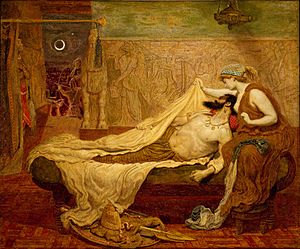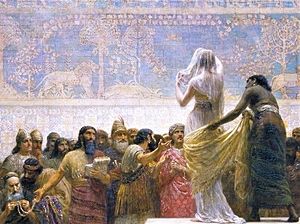The Babylonian Marriage Market facts for kids
Quick facts for kids The Babylonian Marriage Market |
|
|---|---|
| Artist | Edwin Long |
| Year | 1875 |
| Medium | Oil on Canvas |
| Location | Royal Holloway College |
The Babylonian Marriage Market is a famous painting from 1875. It was created by a British artist named Edwin Long. The painting shows a scene from an ancient book called Histories by Herodotus. In this scene, young women in ancient Babylon or Assyria are being offered for marriage. The painting became well-known for how it showed women. People liked how Long used historical details to make the painting interesting and easy to understand. Thomas Holloway bought the painting in 1882. Today, it is owned by Royal Holloway College in London.
Contents
About the Artist
Edwin Long was a painter who mostly created portraits. He was a very private person and didn't like being in public much. Long painted more large pictures than most other artists from the English Royal Artistic Academy. He found ideas for his paintings in old objects, people, and historical writings. For example, the book Histories by Herodotus inspired The Babylonian Marriage Market.
Long's drawings of Spanish life were very popular. This helped him become more famous. He then became a respected artist at the English Royal Art Academy. As his career grew, The Babylonian Marriage Market was shown at the Royal Academy. It sold for 6,605 pounds, which was the highest price ever paid for a painting at that time. This success led Long to travel more, including to Egypt. He was chosen as a Royal Academician in 1876 and again in 1881.
Historical Background
Women's Rights
Many people believe Edwin Long painted The Babylonian Marriage Market because of new laws about women's rights. At that time, women were also fighting for the right to vote, known as the women's suffrage movement. In 1870, a new law was passed. It allowed women to keep their own property even after they got married. Before this law, a married woman's property would automatically go to her husband.
Holloway College points out that while this law was a big step forward, many women still wanted more changes. They kept asking for greater fairness.
Ancient Art and Audiences
A leading Art Historian and Archaeologist named Bohrer says that The Babylonian Marriage Market was special. It mixed Western painting styles with stories from ancient Eastern cultures. People in England at the time had already seen many artworks about Babylonia and Assyria. So, they were familiar with these ancient themes.
The Painting Itself
Painting Details
The Babylonian Marriage Market is a large painting. It is about 172.6 centimeters (68 inches) high and 304.6 centimeters (120 inches) wide. Long used oil paints on a canvas to create it.
The painting is done in a style called Realism. This means it tries to show things as they really look. Realism was very popular during the Victorian Era. Art lovers and academies in England thought Realism was a very important type of art.
What the Painting Shows
In the front of the painting, there is a line of Babylonian women. They are sitting and facing the viewer. These women are brides waiting to be offered for marriage. They are on a white stone platform in the middle of the painting. On this platform, the first bride is being offered. Another woman with darker skin is showing her. To their left, an auctioneer stands, presenting the woman to be sold.
In the background, a crowd of men has gathered. They are bidding on the women. The crowd includes men from different levels of wealth and society. They are busy with various activities. Bohrer notes that the painting shows how women were treated like items to be bought and sold in this market system.
The Setting
Bohrer suggests that Long imagined the place of sale to look like a 19th-century auction house. By doing this, Long made the painting more striking for people living in the Victorian era. Shireen Huda strongly believes that Long was intentionally showing a modern auction house. She thinks it was likely an auction space used by Christie's in London. Huda also suggests that Long painted the famous auctioneer Thomas Woods as the auctioneer character in the artwork.
People in England in 1875 were likely familiar with the settings of Babylon and Assyria. It is thought that Long combined ideas from both Babylon and Assyria to create a mixed Eastern setting.
How it is Arranged
It's not clear why Long chose this arrangement for his painting. There are different ideas about how it compares to Herodotus's original story. Herodotus described the event happening in the middle of a village. The men stood in a circle around the women, not a line.
However, Long's painting is set in a building that looks like a modern auction house. The men are gathered in a line, not a circle. Bohrer thinks Long changed Herodotus's story on purpose. He wanted it to connect more with people in 1875. Imogen Hart believes Long might have used a different translation of Herodotus's work. This translation by George Swayne described the women in a line.
Hart also points out that Long made the women sit at the same level. This creates a strong sense of equality, not a ranking. She argues this shows Long's thoughts on the Babylonian custom. The first bride in the painting faces away from the viewer. This means you cannot see her face. This choice, along with hiding the faces of the "ugliest" and "most beautiful" brides, is seen as Long's way of saying that beauty is very personal and hard to judge objectively.
Who Owns It Now
The painting is currently in the Picture Gallery at Royal Holloway College. Thomas Holloway bought it in 1882. It set a record at the time, selling for £6,615. This was the highest price ever paid for a painting by a living artist.
Inspirations
Long said he was always inspired by the works of John Phillip. Phillip was Long's teacher and a well-known English painter. Like Long, he painted many scenes of Spanish life.
The painting was inspired by a part of Herodotus's Histories. Long also copied some images from Assyrian objects found in the British Museum. The way the painting is arranged also takes ideas from Victorian art auctions. The Graphic newspaper noted Long's lasting interest in myths and events from ancient history, especially those described by Herodotus.
Bohrer explains that artists like Long used ancient Babylonian and Assyrian objects. They didn't use them to perfectly recreate the past. Instead, they used them to inspire their imaginations. They added details to make their ideas of Babylon more vivid. For example, the tiled floor in Ford Madox Brown's The Dream of Sardanapalus (mentioned above) is an example of this. Bohrer argues that ancient Assyrian and Babylonian buildings would not have had such tiled floors.
The painting also included designs from ancient objects. For example, a carved stone with a handle, possibly from Elam, was used in the decoration of the white platform in the middle of the painting. This stone was found in a very old Sumerian king's building (around 2500 BCE).
See also
- John Phillip
- Queen Esther (Another painting by Edwin Long)






